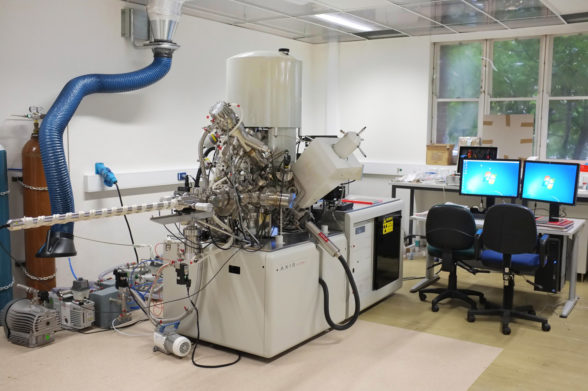X-Ray Surface Analysis Facility
The Western Australian X-Ray Surface Facility (XSAF) provides access to a state-of-the-art X-ray photoelectron spectroscopy system for studying surface elemental and chemical composition.
Techniques
- X-ray photoelectron spectroscopy (XPS): monochromated Al (1486.7 eV) or Ag (2984.3 eV) X-ray sources, or flood Al/Mg source. Area or spot spectroscopy.
- XPS imaging: field of view 800×800 microns, resolution ~3-5 microns, chemical mapping.
- Argon ion gun sputtering: monoatomic or cluster beam cleaning and depth profiling.
- Electron neutraliser filament for insulating samples.
Instrument
Kratos AXIS Ultra DLD X-ray photoelectron spectroscopy system with imaging hemispherical analyser, monochromated Al and Ag X-ray sources, Ag/Mg X-ray flood source, argon gas cluster ion gun, field emission electron source and ultra-violet helium lamp.
Applications
X-ray photoelectron spectroscopy (XPS) is a non-destructive technique used to probe the elemental and chemical composition of the first 2-5 nm of a sample surface. All elements heavier than helium can be detected down to an atomic concentration of 0.1-1%.
Soft Matter and Organic Chemistry
XPS has excellent sensitivity to light elements and is highly suited to studying the surface chemistry of soft organic systems – examples include molecular uptake on surfaces and the chemical composition of polymer films.
Bonding and Electronic Structure
XPS spectra are highly sensitive to the bonding environment of the atoms in the sample. Properties such as oxidation state and highest occupied molecular orbital can be measured.
Materials Processing
Industrial and laboratory processing often changes the surface of materials. XPS is widely used to quantify the presence of adsorbed contaminants and/or chemical changes to the processed materials (e.g. oxidation).
Delicate Samples
XPS requires no coating or special sample preparation, just that the sample be ultra-high vacuum compatible. The technique is non-destructive, though ion-gun sputtering can be used if desired to etch away a surface region and expose the bulk material.


